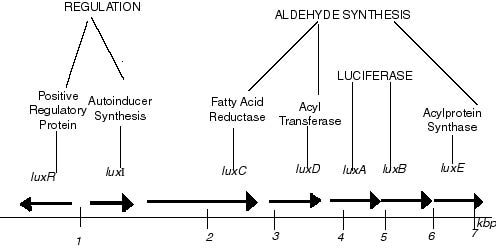Team:Cambridge/References/ProjectBioluminescence/Luciferase
From 2010.igem.org

Mutant luciferase (P. pyralis)
- [http://www.ncbi.nlm.nih.gov/nuccore/AB261988.1 Mutant Enhanced Photon Initiating Complex (EPIC) Luciferase (P.pyralis) Sequence]
- [http://www.ncbi.nlm.nih.gov/pubmed/10529195 Site-directed mutagenesis of firefly luciferase active site amino acids: a proposed model for bioluminescence color]
- [http://www.ncbi.nlm.nih.gov/pubmed/12044905 Improved practical usefulness of firefly luciferase by gene chimerization and random mutagenesis]
Bacterial Bioluminescence
- Vibrio Fischeri
- Vibrio Harveyi
- Genetics of luxCDABE (adapted from wikipedia)
- [http://parts.mit.edu/wiki/index.php/Lux_operon| 2006 attempts at BioBricking the lux operon]
- Notes
- [http://partsregistry.org/Lux The lux wiki from parts registry]
- [http://www.ncbi.nlm.nih.gov/nuccore/AF170104.1?report=graph&log$=seqview NCBI Lux operon sequence]
- [http://partsregistry.org/Part:BBa_G10001 parts registry lux operon] -currently waiting on an email to see how useful/available this part is
- IMPORTANT INFO
- [http://partsregistry.org/Part:BBa_J70008 The Photorhabdus luminescens luxCDABE operon in the registry]
Plasmid experiment
- [http://departments.kings.edu/biology/lux/bacterial.html Vibrio plasmid experiment] -possible source of lux operon
- [http://departments.kings.edu/biology/lux/index.html] - Transformation protocol for students from basics - includes several plasmids
- Plan
- set plasmid 555 into a BioBrick
- replace the promoter? sensitivity tuners?
Transformation Experiment to test Firefly luciferase in registry
- Firefly luciferase is in the registry as BBa_I712019, and have been sent to us as part of the spring 2010 distribution. We need to find a new vector with a bacterial ribosyme binding site, initiator, and a stop codon. Having searched via the catalog in the plasmids section, then in expression plasmids, we have selected a constitutive plasmid.
- The plasmid selected is BBa_JI3002, which is a TetR repressed POPS/RIPS generator, again part of the spring 2010 distribution - kit plate 1, well 13B, plasmid pSB1A2. It was proven to work by UMN iGEM 2009.
 "
"
